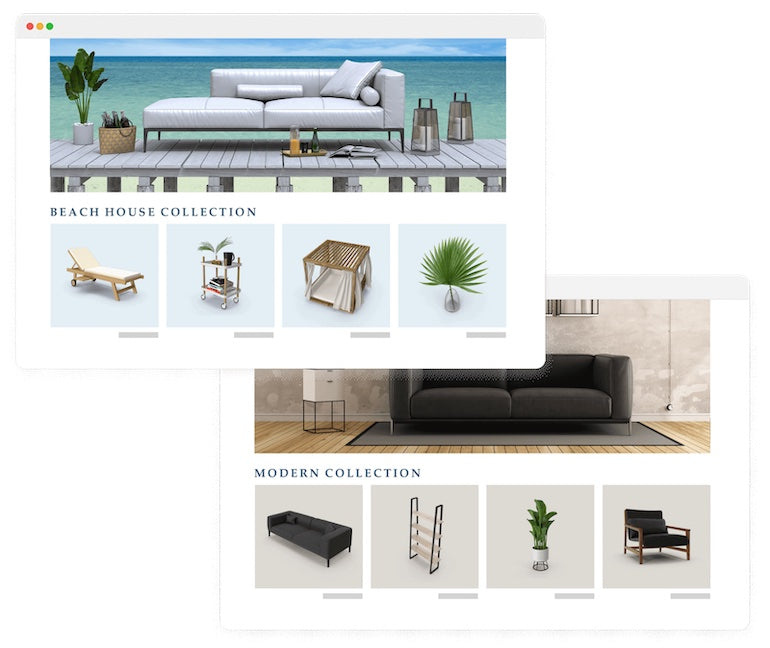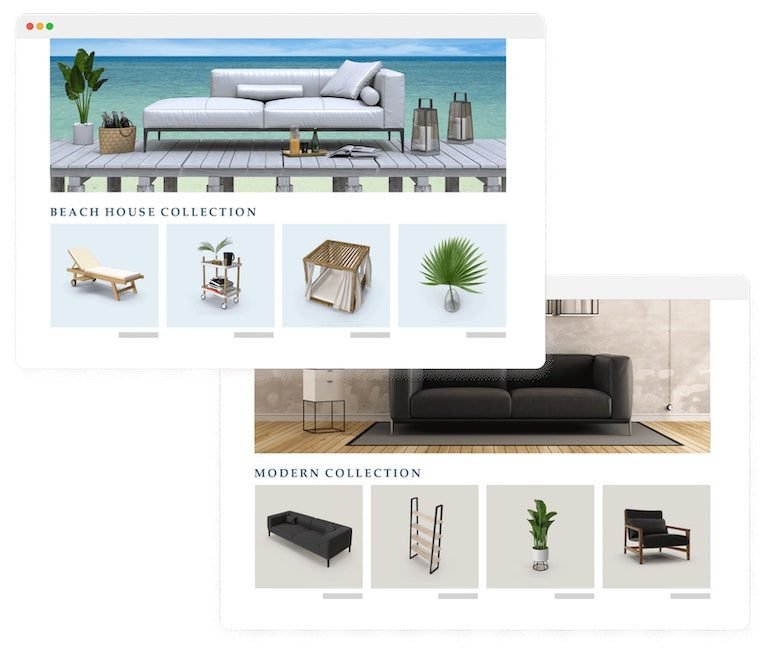[ad_1]
It’s evident that brands and retailers that effectively create personalized shopping experiences for individual customers can drive customer loyalty and increase sales. Customers are 76 percent more likely to consider buying from brands that personalize the consumer experience, according to a 2021 report by McKinsey & Company.
There are many ways to help your merchant clients personalize shopping experiences for their customers—but what strategies are actually successful? And, crucially, what mistakes should brands avoid when incorporating personalization into their ecommerce strategy?
For this article, we quizzed leading Shopify Partners and personalization experts for their insights into the biggest personalization pitfalls you should avoid and what to do instead to create more engaging digital customer experiences on your clients’ ecommerce stores.
Let’s start with a look at how segmentation can help tailor the shopping experience to specific customer groups and increase your client’s conversions.
Build apps for Shopify merchants
Whether you want to build apps for the Shopify App Store, offer custom app development services, or are looking for ways to grow your user base, the Shopify Partner Program will set you up for success. Join for free and access educational resources, developer preview environments, and recurring revenue share opportunities.
1. Focusing personalization only on the core customers
One of the biggest mistakes Francis Pilon, director of sales at LimeSpot, sees brands make when approaching personalization is to assume that a baseline implementation targeting their core customers is sufficient and will have a positive impact on all shoppers on their site.
“Even within a common demographic or a targeted product set, visitors have different needs, shopping goals, and buying behaviors,” Pilon explains. “The impact of only targeting that baseline user is that other segments of visitors do not connect with the brand experience and remain unengaged.”
The impact of only targeting that baseline user is that other segments of visitors do not connect with the brand experience and remain unengaged.
Pilon suggests considering a skincare brand whose primary target market is women: The core demographic is women aged 25-40, however there are others who come to the site. For example, there may be a strong segment of older women, with different needs and different buying criteria, who want to be acknowledged with a customized experience. Understanding how to effectively tailor their shopping experience and delight them can have a huge impact on a brand’s bottom line.
So what steps should you take to more effectively personalize your merchant clients’ shopping experience for these audiences?
Pilon recommends starting by defining key segments based on their lifecycle stage, affinity, and context, such as first-time visitors, collections, and geolocation. Using a platform that provides real-time segmentation can both help you identify what these segments are, and give you the ability to target them.
“For instance, if a majority of first-time shoppers show interest in sustainable practices you may want to show them social proof on the homepage for validation,” Pilon suggests. “Whereas returning customers who are already knowledgeable about the brand may want to easily find related items to what they’ve purchased in the past.”
Once you have your hypotheses, Pilon advises beginning with some basic customization—as few as two to three components of the shopping experience, such as product recommendations, category merchandising, and content, can make the difference. Then A/B test to measure effectiveness; adjust, expand, and repeat.
Begin with some basic customization, then A/B test to measure effectiveness. Adjust, expand, and repeat.
Most brands already understand the benefit of segmentation-based customizations, Pilon says. However, until recently, only larger brands had the resources required to turn such knowledge into actionable insights. Fortunately there are now powerful, affordable, low-effort personalization solutions for brands of all sizes—and using a one-size-fits-all model is leaving money on the table.

2. Limiting personalization to just one area of your store
Kate Collinson, an ecommerce consultant and growth marketer specializing in Shopify and Shopify Plus, warns against just focusing on one area of a store when implementing personalized experiences.
“Think about how it can provide a customer value throughout every touchpoint with your business,” she advises. “Personalization is a value exchange—the customer needs to see value in handing over their private information.”
Collinson points to her client, Shopify merchant Kat The Label, as a best practice example. The Australian lingerie store uses a quiz to help customers to find their size in a product, and then remembers it throughout the browsing experience, so the customer is reminded of their relevant size throughout the entire journey.
Collinson takes it a step further by syncing this data with the CRM in combination with what is received from other platforms such as Okendo reviews and back-in-stock notifications to segment communications with customers.

3. Not tracking data from the experience itself
Another common mistake Collinson sees merchants make is investing a lot of time and energy in using the data from their CRM or survey to create a personalized experience for their customers, but then not setting up data points to assess how it impacts the business’ bottom line.
As a Shopify Partner you can guide merchants on this to demonstrate the return on any work. Focus on the metrics that are going to move the needle, not just vanity metrics of what’s been achieved.
“Whether it’s using Google Tag Manager or an in-built analytics platform, identify the metrics that would prove something is working. And ensure you set up any relevant tags upfront so you can analyze how customers are responding to your personalized experience,” Collinson suggests.
For example, if you’re using custom CRM data to trigger an automated series to guide the customer, this may be built into the platform you’re using. But Collinson recommends that if you’re customizing what the customer interacts with on the homepage through something like Shopify Scripts, you’ll need to set up custom tags to analyze this data in Google Analytics or a similar platform.
The biggest errors stores make can be easily fixed with developer support.
Meanwhile, Freddie Wynne and Adam Goodman, product managers at LoyaltyLion, believe the biggest errors stores make can be easily fixed with developer support. They suggest avoiding the following four personalization pitfalls and advise on what to do instead to drive a better digital customer experience:
4.Not pre-filling fields where possible
This one is simple: don’t make your customers do any extra work, especially if you want to provide a seamless, personalized shopping experience. Pre-populating information for customers removes friction and improves conversion rates.
5. Not showing prices or shipping rates in local currencies
Research shows that 76 percent of consumers prefer making payments in their local currency, and they certainly don’t want to be surprised with generic shipping rates. Reduce basket abandonment by delivering on the details and localizing their shopping experiences.
6. Not creating a sense of urgency
Notifications around limited stock or back-in-stock alerts can prompt shoppers to make their next purchase sooner, or prevent them from dropping off completely. Applying order cut-off times for next-day delivery can also help to move them through their transaction faster.
7. Not capitalizing on the integrations between Shopify apps
Tools should be set up to talk to one another so that data points can be passed from one to another to deliver more personalized and engaging experiences. This can include, for example, passing loyalty data points from LoyaltyLion into emails or SMS sent from Klaviyo, or enabling support teams to see loyalty statuses and points balances as they work within Gorgias.
It’s essential to keep in mind that personalization can also lead to negative outcomes if not executed correctly, warns Juan Manuel Gonzalez, founder and CEO of strategy retail consulting firm G & Co.
Personalization can also lead to negative outcomes if not executed correctly.
Specifically, Gonzales points to three critical mistakes:
8. Invading customers’ privacy by collecting too much personal information
Brands should only ask for information that is relevant to the shopping experience and avoid using data for purposes other than enhancing the customer experience. Moreover, companies should implement robust security measures to protect customers’ sensitive information from data breaches.
9. Over-personalizing the experience
While personalization is meant to improve the shopping experience, bombarding customers with too many personalized recommendations and advertisements can quickly become overwhelming and alienating. Companies should strive for a balance between personalization and a customer-friendly experience.
10. Personalizing experiences based solely on demographic information or past purchases
Personalization must go beyond this and take into account customers’ current context and behavior. For example, if a customer is browsing on a mobile device, they may have different needs and preferences than if they were browsing on a desktop computer, vice versa.
Ross Beyeler, the chief operating officer at Trellis Commerce, meanwhile thinks brands should also consider the following seven mistakes when incorporating personalization into their ecommerce strategy:
11. Limiting product recommendations to the PDP
A product detail page (PDP) will likely have a “recommended products” section below the “add to cart button.” While this is a great starting point for providing product recommendations and upselling customers, there are many other areas within your website that you should consider.
Tools like Nosto make adding product recommendations to search results, collection pages, landing pages, and the shopping cart easy and personalized based on customer behavior and shopping history.
12. Missing out on empty search results
If your company sells more than a handful of SKUs, customers will likely search for something that leads them to a “dead end.”
Instead of giving them a “No results” message, tools like Algolia allow you to take note of these searches and set up custom redirects or product recommendations that might be a close match to what customers are seeking.
13. Forgetting to do retargeting
Retargeting customers already engaged with your brand is one of the most turnkey ways of personalizing your interaction with them.
Tools like Yotpo allow you to capitalize on products viewed, products added to cart, etc., which can be a valuable way to convert visitors into buyers.
14. Discounting low margin products
Promotions such as discounts and offers are essential in driving sales, particularly for value-minded customers. However, failing to keep an eye on product margins can lead to significant losses. You’ll want to make sure whatever promotions you’re running consider the “landed cost” of products (i.e. COGS, shipping/handling, return rates, etc.).
15. Overlooking first-party data
Personalization is about using what you know about customers to inform how you engage with them. Since iOS14, much of the previously procured data from social media platforms is no longer accessible.
That change has given rise to “first-party data,” where merchants introduce tactics such as post-purchase surveys using tools like Fairing to build their own set of customer data.
16. Giving away more than you need to
Pricing discounts are a great way to drive conversion, but you should consider testing “how much is enough” to ensure you’re not giving away more margin than you need to.
Apps like Dexter allow you to run A/B tests on product prices, and platforms like Talon.One will enable you to personalize and test your promotional campaigns as a whole.
17. Failing to differentiate by customer journey
Not all visitors are created equal. You’ll want to offer different promotions and recommendations based on where they are in their “customer journey.” Consider whether they’re a new vs. returning customer, first-time or repeat visitor, someone who has spent a lot of time on the website, etc.
Tools like Bloomreach allow you to incorporate this content into content, promotion, and product personalization.

18. Forcing brands to work with disconnected tech stacks
Christina Donati, content and partner marketing lead at Alloy Automation, explains that at one point in the past few years the SaaS companies that power ecommerce tech stacks deprioritized integrations. And she understands why:
“It was difficult for these startup companies to balance building integrations while improving their product,” Donati points out. “One of these things had to give. Unfortunately, building out core product features takes priority. So, many companies put integrations on hold to increase market share and reach more customers. Because of this, we see more siloed tools than ever.”
According to Donati, however, brands need integrations, and as more siloed tools enter the market, brands are left with disconnected tech stacks—and lots of manual work completing time-consuming tasks.
“This is a recipe for churn for SaaS companies that aren’t offering integrations,” Donati cautions. “For brands, this means they can’t automate specific tasks and are left spending hours every week on manual work, or they’re forced to pay agencies a lot of money for custom integrations.”
Donati therefore believes that tech companies need to get back to also prioritizing integrations for their customers: “It helps with product retention and enables your partnership team to go to market with other platforms in the space strategically.”
19. Not using automation to work smarter
Every ecommerce business has finite resources, time, and cost when it comes to producing quality products along with a quality customer experience. Donati argues that to improve any area, others must take a hit:
“Launch a new project improving quality? Cost, resources, and time will increase. Try to reduce the budget? Increase the time needed on projects. Reduce time on a project? Increase cost and resources.”
This resource, time, and cost trade-off is true for every business owner. Everyone is juggling their balance of resources, time, and cost to operate. As businesses grow, the pressures of daily operations can become overwhelming, however. Time that could be used for key tasks like refining a product offering and engaging with customers is often sucked up by urgent but mundane details such as restocking materials or navigating customer service issues. It’s easy to get bogged down in all these small challenges.
So how do you help your clients stay on top of it? Donati believes the answer is investing in automation tools, which can help manage these repetitive tasks across marketing, customer support, and back-office operations (like shipping and order fulfillment).
20. Thinking there’s still an “ecommerce growth playbook” that will guarantee success
In the past, it was easier to funnel money into paid advertising and see an ROI. This isn’t the case anymore—there’s no single blueprint for growth.
These days there are many different ways to grow a business. Here are three Donati recommends you should make your client aware of:
- Focus on providing value to your target customers on the channels you enjoy creating content for the most. If you prefer to write, start a blog and focus on SEO. If you like being on video, get on TikTok. Build an organic engine early and consistently.
- Determine how to cut costs without impacting your product quality or customer experience. For example, change your packaging to a cheaper, sustainable option. Or, automate your operations tasks so you waste less time on repetitive day-to-day things.
- Build true connections with your customers—not a transactional relationship. If we head into a potential recession, people will be cautious about where they spend their money. Deeper connections mean customers feel comfortable supporting your mission and values, even during a downturn.
All of these mistakes feed into whether the personalized shopping experiences you create for your client’s customers will be successful. Some mistakes can be easily avoided while others can take some time to undo if they’re already embedded practices in your client’s online store. But personalization doesn’t have to be complicated. There are some simple ways to integrate personalized shopping into the customer experience.
One easy way to introduce product personalization
To offer shoppers a personalized shopping experience when they’re browsing your client’s store, you could start with something as simple as offering color, flavor, fabric, and texture variants on the product page based on the type of customer who visits that page.
Deb Mecca, director of marketing at Shopify app In Cart Upsell, points to two examples:
On Olipop’s product pages, a shopper can click on a specific flavor variant to see the exact product they’re interested in, showcased on the left.

And bridal boutique Gigi & Olive offers available color swatches for products to allow the shopper to personalize their garment. When considering a color, the shopper can choose from a drop-down menu of color options based on the color scheme of their wedding.

“This makes the customer feel more connected with their decision when purchasing the product because they are viewing what they will be receiving when their order arrives,” Mecca explains.
Differentiate your clients’ stores with careful personalization
Personalization has become a critical component of ecommerce success. It’s a relatively straightforward way to offer shoppers what they want when purchasing from an online store.Personalization is a powerful tool for brands and retailers but it must be executed carefully to be most effective.
If done well (and this means unobtrusively and throughout the customer journey), personalization poses a huge opportunity to really connect with each type of customer within your client’s audience. This is especially true for smaller merchants who can make fast decisions and are flexible to experiment.
So, keep the above advice in mind when supporting your merchants on their personalization journey and you’re well on your way to helping them increase their conversions.
[ad_2]
Source link

